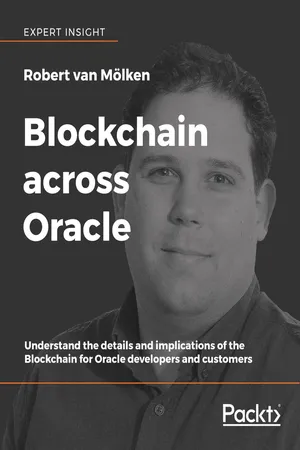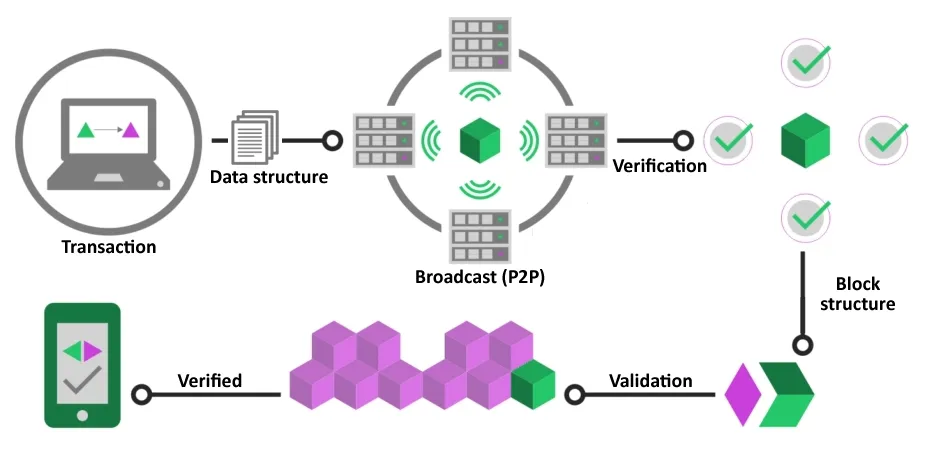
Blockchain across Oracle
Understand the details and implications of the Blockchain for Oracle developers and customers
- 530 pages
- English
- ePUB (mobile friendly)
- Available on iOS & Android
Blockchain across Oracle
Understand the details and implications of the Blockchain for Oracle developers and customers
About This Book
Learn what the Blockchain is, what the differences between available blockchain platforms are, how to work with Oracle's Blockchain Cloud Service, and how Blockchain can change the direction of your Oracle work and the focus of your customers.
Key Features
- A professional orientation of the Blockchain for Oracle developers and customers
- Learn what the Blockchain is and how it will affect for you and your customers
- Learn how blockchain will disrupt traditional cross-organizational applications
- Implement your own Blockchain on Oracle and develop your first smart contract
- Industry directions of the Blockchain to help you decide where to develop your skills
Book Description
Blockchain across Oracle gives you the professional orientation to Blockchain that you need as an Oracle developer in today's changing world. Written and prepared for you by Oracle Developer Champion Robert van Mölken, this book gets you up to speed with the details of the Blockchain - core concepts, how to implement Oracle's Blockchain Cloud Service, industry implications for the Blockchain, and how the Blockchain will affect your Oracle customers.
Robert van Mölken introduces you to the history and concepts of the Blockchain. You'll really get to understand the Blockchain inside and out, as an Oracle developer or solution architect. You'll understand the Blockchain flow, and how the hashes and chains create a new decentralised paradigm for you as an Oracle developer. You'll gain insights into how the Blockchain affects Oracle developers and customers in this modern and disruptive era. You'll see how the Blockchain concepts work in this new world where Assets, Transactions, Security, and Privacy, can all be sustained across a decentralized system for your customers.
Then you'll find a detailed look at the cutting-edge Oracle middleware solutions. You'll learn about Hyperledger Fabric, the opensource Blockchain framework used by Oracle as its core, and how to set up your own Oracle Blockchain Network. You'll design and develop a smart contract, and learn how to run it on the Oracle Blockchain Cloud Service.
The final part of the book looks at how the Blockchain will affect your customers across various industry sectors. By studying industry trends in the financial services sector, healthcare industry, and the transport industry, you'll discover how the options and possibilities for you and your clients are being transformed by the Blockchain across Oracle. You'll complete this professional orientation by looking at Blockchain trends and future directions.
What you will learn
- A full introduction to the Blockchain
- How the Blockchain affects Oracle developers and customers
- Core concepts including blocks, hashes, and chains, assets, transactions, and consensus
- How to work with Oracle Cloud to implement a Blockchain Network
- Design, develop, and run smart contracts on the Oracle Blockchain Cloud Service
- Blockchain security and privacy for Oracle developers and clients
- Public and private Blockchain decisions for Oracle architects and developers
- Industry analysis across finance, governance, and healthcare sectors
- Industry trends and the future of the Blockchain technology
Who this book is for
This book is a professional orientation for all Oracle developers, solution architects, and decisions makers involved in Oracle system and future development.
Frequently asked questions
Information
Part I
An Introduction to the Blockchain
- What is a blockchain and how does it work?
- What is the architecture behind the blockchain ecosystem?
- What are the differences between public and private blockchains?
- How secure is a blockchain, and what about an individual's privacy?
- What kind of applications can run on a blockchain?
What is a blockchain?




How does a blockchain work?

Table of contents
- Title Page
- Copyright and Credits
- Packt Upsell
- Contributors
- Preface
- Part I
- An Introduction to the Blockchain
- How Blockchain Will Disrupt Your Organization
- Part II
- Blockchain 101 - Assets, Transactions, and Hashes
- Blockchain 101 - Blocks, Chains, and Consensus
- Blockchain 101 - Security, Privacy, and Smart Contracts
- Understanding the Blockchain Data Flow
- Public Versus Permissioned Blockchains and their Providers
- Part III
- Ethereum Versus Hyperledger
- Building a Next-Generation Oracle B2B Platform
- Introducing the Oracle Blockchain Cloud Service
- Setting Up Your Permissioned Blockchain
- Designing and Developing Your First Smart Contract
- Deploying and Testing Your First Smart Contract
- Configuring, Extending, and Monitoring Your Network
- Part IV
- Blockchain Across the Financial Services Industry
- Blockchain Across the Transportation Industry
- Blockchain Across the Healthcare Industry
- Future Industry and Technology Directions
- Other Books You May Enjoy